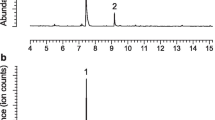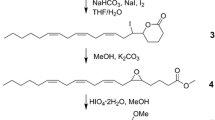Abstract
Males of several species in the large cerambycid beetle subfamily Lamiine, native to South and North America, are known to produce aggregation-sex pheromones composed of three related structures: the sesquiterpene catabolic product geranylacetone, its corresponding alcohol (known as fuscumol), and the acetate ester of the alcohol (fuscumol acetate). Here, we show that males of two lamiine species native to the eastern USA, Astylopsis macula (Say) and Leptostylus transversus (Gyllenhal) (both tribe Acanthocinini), produce pheromones composed of the structurally related (S)-6-methylhept-5-en-2-ol ([S]-sulcatol). Males of both species also produced 6-methylhept-5-en-2-one (sulcatone), and males of A. macula produced trace amounts of (R)-fuscumol acetate. Field experiments demonstrated that both species were attracted by (S)-sulcatol. Sulcatone was not attractive as a single component, nor did it influence attraction of A. macula to (S)-sulcatol, while its effect on L. transversus was unclear. Data from the field experiments, and a separate experiment using traps fitted with a timer mechanism that rotated trap jars, revealed that the two species overlap only slightly in both seasonal and daily flight period, thus minimizing interspecific attraction. Racemic fuscumol acetate and fuscumol antagonized attraction of both species to sulcatol. The identification of sulcatol as a cerambycid pheromone extends the known range of pheromone components in the subfamily Lamiinae.



Similar content being viewed by others
References
Beutenmiller W (1896) Food-habits of north American Cerambycidae. J N Y Entomol Soc 4:73–81
Cardé RT (2014) Defining attraction and aggregation pheromones: teleological versus functional perspectives. J Chem Ecol 40:519–520
Craighead FC (1923) North American cerambycid larvae: a classification and the biology of north American cerambycid larvae. Canadian Dept Ag Bull 27 – New series (Technical):1–239
El-Sayed AM (2018) The pherobase: database of pheromones and semiochemicals. http://www.pherobase.com. Accessed 7 Dec 2018
Hanks LM, Millar JG (2013) Field bioassays of cerambycid pheromones reveal widespread parsimony of pheromone structures, enhancement by host plant volatiles, and antagonism by components from heterospecifics. Chemoecology 23:21–44
Hanks LM, Millar JG (2016) Sex and aggregation-sex pheromones of cerambycid beetles: basic science and practical applications. J Chem Ecol 42:631–654
Hanks LM, Reagel PF, Mitchell RF, Wong JCH, Meier LR, Silliman CA, Graham EE, Striman BL, Robinson KP, Mongold-Diers JA, Millar JG (2014) Seasonal phenology of the cerambycid beetles of east-Central Illinois. Ann Entomol Soc Am 107:211–226
Hanks LM, Mongold-Diers JA, Mitchell RF, Zou Y, Wong JCH, Meier LR, Johnson TD, Millar JG (2019) The role of minor pheromone components in segregating 14 species of cerambycid beetles of the subfamily Cerambycinae. J Econ Entomol (in press)
Hodges RJ, Birkinshaw LA, Farman DI, Hall DR (2002) Intermale variation in aggregation pheromone release in Prostephanus truncatus. J Chem Ecol 28:1665–1674
Hughes GP, Zou Y, Millar JG, Ginzel MD (2013) (S)-Fuscumol and (S)-fuscumol acetate produced by a male Astyleiopus variegatus (Coleoptera: Cerambycidae). Can Entomol 145:327–332
Hughes GP, Meier LR, Zou Y, Millar JG, Hanks LM, Ginzel MD (2016) Stereochemistry of fuscumol and fuscumol acetate influences attraction of longhorned beetles (Coleoptera: Cerambycidae) of the subfamily Lamiinae. Environ Entomol 45:1271–1275
Lingafelter SW (2007) Illustrated key to the longhorned wood-boring beetles of the eastern United States. Special publication No. 3, Coleopterists Society, North Potomac, pp 206
Linsley EG, Chemsak JA (1995) The Cerambycidae of North America, part VII, no. 2: taxonomy and classification of the subfamily Lamiinae, tribes Acanthocinini through Hemilophini. Univ Calif Pub Entomol 114:1–292
Meier LR, Zou Y, Millar JG, Mongold-Diers JA, Hanks LM (2016) Synergism between enantiomers creates species-specific pheromone blends and minimizes cross-attraction for two species of cerambycid beetles. J Chem Ecol 42:1181–1192
Millar JG, Hanks LM (2017) Chemical ecology of cerambycids. In: Wang Q (ed) Cerambycidae of the world: biology and pest management. CRC Press/Taylor & Francis, Boca Raton, pp 161–208
Millar JG, Hanks LM, Moreira JA, Barbour JD, Lacey ES (2009) Pheromone chemistry of cerambycid beetles. In: Nakamuta K, Millar JG (eds) Chemical ecology of wood-boring insects. Forestry and Forest Products Research Institute, Ibaraki, pp 52–79
Millar JG, Mitchell RF, Mongold-Diers JA, Zou Y, Bográn CE, Fierke MK, Ginzel MD, Johnson CW, Meeker JR, Poland TM, Ragenovich IR, Hanks LM (2018) Identifying possible pheromones of cerambycid beetles by field testing known pheromone components in four widely separated regions of the United States. J Econ Entomol 111:252–259
Mitchell RF, Graham EE, Wong JCH, Reagel PF, Striman BL, Hughes GP, Paschen MA, Ginzel MD, Millar JG, Hanks LM (2011) Fuscumol and fuscumol acetate are general attractants for many species of cerambycid beetles in the subfamily Lamiinae. Entomol Exp Appl 141:71–77
Mitchell RF, Reagel PF, Wong JCH, Meier LR, Silva WD, Mongold-Diers J, Millar JG, Hanks LM (2015) Cerambycid beetle species with similar pheromones are segregated by phenology and minor pheromone components. J Chem Ecol 41:431–440
SAS Institute (2011) SAS/STAT 9.3 user's guide. SAS Institute Inc., Cary
Sokal RR, Rohlf FJ (1995) Biometry, 3rd edn. WH Freeman and Co., New York
Sweeney J, Silk PJ, Gutowski JM, Wu J, Lemay MA, Mayo PD, Magee DI (2010) Effect of chirality, release rate, and host volatiles on response of Tetropium fuscum (F.), Tetropium cinnamopterum Kirby, and Tetropium castaneum (L.) to the aggregation pheromone, fuscumol. J Chem Ecol 36:1309–1321
Vidal DM, Fonseca MG, Zarbin PH (2010) Enantioselective synthesis and absolute configuration of the sex pheromone of Hedypathes betulinus (Coleoptera: Cerambycidae). Tetrahedron Lett 51:6704–6706
Wong JCH, Meier LR, Zou Y, Mongold-Diers JA, Hanks LM (2017) Evaluation of methods used in testing attraction of cerambycid beetles to pheromone-baited traps. J Econ Entomol 110:2269–2274
Zarbin PH, Fonseca MG, Szczerbowski D, Oliveira AR (2013) Biosynthesis and site of production of sex pheromone components of the cerambycid beetle, Hedypathes betulinus. J Chem Ecol 39:358–363
Acknowledgements
We thank Suzanne Vachula and Alexander Hazel for assistance with field work. For access to field sites, we thank S. Buck and the University of Illinois Committee on Natural Areas and the Vermilion County Conservation District. This research was supported by grants from The Alphawood Foundation of Chicago to LMH, and grants from USDA National Institute of Food and Agriculture (numbers 2012-67013-19303 and 2015-67013-23173) and USDA-APHIS (grant number 15-8130-1422-CA) to LMH and JGM.
Author information
Authors and Affiliations
Corresponding author
Rights and permissions
About this article
Cite this article
Meier, L.R., Millar, J.G., Mongold-Diers, J.A. et al. (S)-Sulcatol Is a Pheromone Component for Two Species of Cerambycid Beetles in the Subfamily Lamiinae. J Chem Ecol 45, 447–454 (2019). https://doi.org/10.1007/s10886-019-01071-7
Received:
Revised:
Accepted:
Published:
Issue Date:
DOI: https://doi.org/10.1007/s10886-019-01071-7




